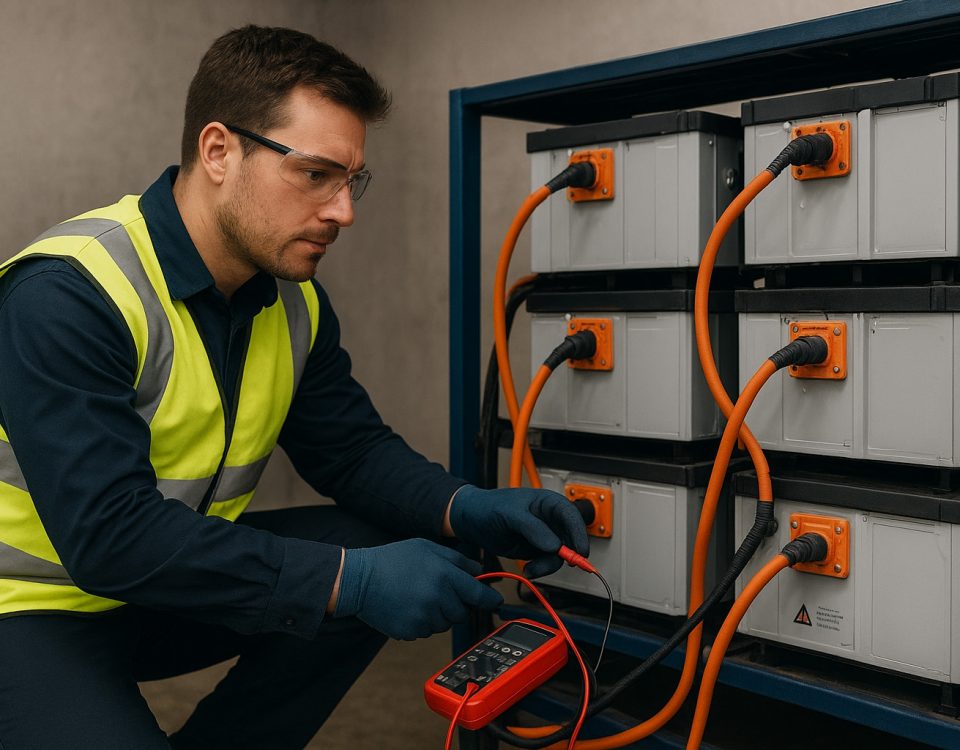เนื่องจากความต้องการสำหรับ แบตเตอรี่ลิเธียม ยังคงเพิ่มขึ้นอย่างต่อเนื่องในหลากหลายอุตสาหกรรม ตั้งแต่ยานยนต์ไฟฟ้าไปจนถึงระบบพลังงานหมุนเวียน การรับประกันความน่าเชื่อถือจึงกลายเป็นสิ่งสำคัญยิ่ง อย่างไรก็ตาม แม้แต่แบตเตอรี่ที่ล้ำสมัยที่สุดก็อาจประสบปัญหาได้ การเข้าใจวิธีการวินิจฉัยและแก้ไขปัญหาแบตเตอรี่ลิเธียมที่พบบ่อยอย่างมีประสิทธิภาพสามารถช่วยเพิ่มประสิทธิภาพการทำงานและความพึงพอใจของผู้ใช้ได้อย่างมาก บทความนี้จะนำเสนอวิธีการปฏิบัติจริงในการระบุและแก้ไขข้อบกพร่องของแบตเตอรี่ลิเธียมที่พบได้บ่อย พร้อมทั้งสำรวจกลยุทธ์ในการยกระดับประสบการณ์การใช้งานโดยรวม
การเข้าใจปัญหาทั่วไปของแบตเตอรี่ลิเธียม
แบตเตอรี่ลิเธียมเป็นที่รู้จักในด้านความหนาแน่นของพลังงาน, ความยาวนาน, และประสิทธิภาพ, แต่พวกมันไม่สามารถหลีกเลี่ยงปัญหาได้. นี่คือปัญหาที่พบได้บ่อยที่สุดที่ผู้ใช้เผชิญ:
-
การสูญเสียความสามารถ เมื่อเวลาผ่านไป แบตเตอรี่ลิเธียมอาจสูญเสียความสามารถในการเก็บประจุ
-
การร้อนเกินไป: อุณหภูมิการทำงานที่สูงสามารถนำไปสู่การเกิดภาวะความร้อนเกินควบคุม ซึ่งก่อให้เกิดความเสี่ยงด้านความปลอดภัย
-
ความไม่สมดุลของแรงดันไฟฟ้า ในระบบหลายเซลล์ ระดับแรงดันไฟฟ้าที่ไม่สม่ำเสมอสามารถลดประสิทธิภาพการทำงานได้
-
การชาร์จช้าหรือการชาร์จไม่สำเร็จ: ปัญหานี้มักเกิดจากที่ชาร์จเสียหรือปัญหาภายในเซลล์แบตเตอรี่
-
บวมหรือความเสียหายทางกายภาพ: บ่งชี้ถึงปฏิกิริยาเคมีภายในหรือความเค้นเชิงกล
ขั้นตอนการวินิจฉัยทีละขั้นตอน
เพื่อแก้ไขปัญหาอย่างมีประสิทธิภาพ จำเป็นต้องระบุสาเหตุที่แท้จริง นี่คือวิธีการวินิจฉัยปัญหาแบตเตอรี่ลิเธียมอย่างเป็นระบบ:
1. การตรวจสอบด้วยสายตา
เริ่มต้นด้วยการตรวจสอบแบตเตอรี่ว่ามีร่องรอยความเสียหายที่มองเห็นได้หรือไม่ เช่น การบวม การรั่วไหล หรือการกัดกร่อนรอบขั้วแบตเตอรี่ ความบกพร่องทางกายภาพมักบ่งชี้ถึงปัญหาภายในที่ต้องการการดูแลทันที
2. ตรวจสอบระดับแรงดันไฟฟ้า
ใช้มัลติมิเตอร์วัดแรงดันไฟฟ้าของแบตเตอรี่ ตรวจสอบให้แน่ใจว่าแรงดันไฟฟ้าอยู่ในช่วงที่ผู้ผลิตแนะนำ ความแตกต่างอย่างมีนัยสำคัญอาจบ่งชี้ถึงเซลล์ที่หมดหรือทำงานผิดปกติ
3. ตรวจสอบระบบจัดการแบตเตอรี่ (BMS)
ระบบ BMS ตรวจสอบและควบคุมประสิทธิภาพของแบตเตอรี่ ตรวจสอบรหัสข้อผิดพลาดหรือการแจ้งเตือนบนระบบ BMS เพื่อระบุปัญหาเฉพาะ เช่น ความไม่สมดุลของแรงดันไฟฟ้าหรือการเปลี่ยนแปลงของอุณหภูมิ
4. ประเมินอุปกรณ์ชาร์จ
ทดสอบที่ชาร์จด้วยแบตเตอรี่อื่นเพื่อตรวจสอบว่าอุปกรณ์ชาร์จมีข้อบกพร่องหรือไม่ ตรวจสอบให้แน่ใจว่าที่ชาร์จจ่ายแรงดันไฟฟ้าและกระแสไฟฟ้าที่เหมาะสมกับแบตเตอรี่ของคุณ
5. ดำเนินการทดสอบโหลด
ต่อโหลดที่ทราบค่ากับแบตเตอรี่และวัดประสิทธิภาพการทำงานขณะใช้งาน การทดสอบนี้ช่วยระบุปัญหาความจุหรือการลดลงของแรงดันไฟฟ้าอย่างฉับพลัน
วิธีแก้ปัญหาทั่วไปอย่างมีประสิทธิภาพ
1. การสูญเสียความสามารถ
-
สารละลาย: ทำการคายประจุลึกและชาร์จไฟเต็มเป็นระยะเพื่อปรับเทียบแบตเตอรี่ใหม่ หากปัญหายังคงอยู่ ให้พิจารณาเปลี่ยนเซลล์แบตเตอรี่ที่เสื่อมสภาพ
-
การป้องกัน: หลีกเลี่ยงการปล่อยประจุจนหมดและรักษาการชาร์จบางส่วนไว้ระหว่างการเก็บรักษาระยะยาว
2. การร้อนเกินไป
-
สารละลาย: ตรวจสอบระบบระบายความร้อนและตรวจสอบให้มีการระบายอากาศที่เพียงพอ เปลี่ยนเซลล์ที่มีข้อบกพร่องซึ่งทำให้เกิดความร้อนเกิน
-
การป้องกัน: ใช้งานแบตเตอรี่ภายในช่วงอุณหภูมิที่แนะนำและหลีกเลี่ยงการใช้งานเกินกำลัง
3. ความไม่สมดุลของแรงดันไฟฟ้า
-
สารละลาย: ใช้ BMS ที่มีฟังก์ชันการปรับสมดุลเพื่อปรับแรงดันเซลล์ให้เท่ากัน การปรับสมดุลด้วยตนเองอาจจำเป็นสำหรับระบบที่มีความไม่สมดุลอย่างรุนแรง
-
การป้องกัน: ตรวจสอบแรงดันไฟฟ้าของเซลล์อย่างสม่ำเสมอและให้แน่ใจว่ามีการชาร์จไฟในรอบที่สม่ำเสมอ
4. ชาร์จช้าหรือชาร์จไม่เข้า
-
สารละลาย: เปลี่ยนที่ชาร์จที่ไม่เข้ากันหรือชำรุด หากความต้านทานภายในของแบตเตอรี่สูงเกินไป อาจจำเป็นต้องได้รับการบริการจากผู้เชี่ยวชาญ
-
การป้องกัน: ใช้ที่ชาร์จที่ออกแบบมาเฉพาะสำหรับรุ่นแบตเตอรี่ของคุณและตรวจสอบพฤติกรรมการชาร์จ
5. อาการบวมหรือความเสียหายทางกายภาพ
-
สารละลาย: หยุดใช้ทันทีและปรึกษาผู้เชี่ยวชาญเพื่อกำจัดหรือซ่อมแซมอย่างปลอดภัย
-
การป้องกัน: หลีกเลี่ยงการรับแรงกดทางกลและการชาร์จไฟเกิน ซึ่งอาจทำให้เกิดการบวมได้
เครื่องมือนวัตกรรมเพื่อการวินิจฉัยที่ล้ำสมัย
เครื่องมือวินิจฉัยขั้นสูงและแอปพลิเคชันกำลังปฏิวัติ แบตเตอรี่ลิเธียม การบำรุงรักษา. นี่คือเทคโนโลยีที่คุณอาจพิจารณา:
-
การผสานระบบ BMS อย่างชาญฉลาด หน่วย BMS สมัยใหม่ให้ข้อมูลแบบเรียลไทม์เกี่ยวกับอุณหภูมิ, แรงดันไฟฟ้า, และรอบการชาร์จ, ช่วยให้สามารถตรวจจับความผิดปกติได้ตั้งแต่เนิ่นๆ
-
กล้องถ่ายภาพความร้อน: ระบุเซลล์หรือส่วนประกอบที่เกิดความร้อนสูงเกินไปขณะทำงาน
-
การตรวจสอบด้วยระบบ IoT ระบบบนคลาวด์ช่วยให้สามารถตรวจสอบและควบคุมจากระยะไกลได้ ซึ่งช่วยให้มั่นใจได้ถึงประสิทธิภาพการทำงานที่ดีที่สุด
ข้อควรพิจารณาด้านสิ่งแวดล้อมและความปลอดภัย
ในการแก้ไขปัญหาแบตเตอรี่ลิเธียม สิ่งสำคัญคือต้องให้ความสำคัญกับความปลอดภัยและผลกระทบต่อสิ่งแวดล้อมเป็นอันดับแรก ปฏิบัติตามแนวทางเหล่านี้:
-
การกำจัดอย่างปลอดภัย: นำแบตเตอรี่ที่เสียแล้วไปรีไซเคิลผ่านสถานที่ที่ได้รับการรับรองเพื่อป้องกันอันตรายต่อสิ่งแวดล้อม
-
การเตรียมพร้อมรับมือเหตุฉุกเฉิน ติดตั้งระบบดับเพลิงในพื้นที่ทำงานที่ออกแบบมาสำหรับไฟไหม้แบตเตอรี่ลิเธียม
-
ความยั่งยืน: เลือกใช้แบตเตอรี่ที่มีศักยภาพในการรีไซเคิลสูง และผู้ผลิตที่มุ่งมั่นในแนวทางที่เป็นมิตรต่อสิ่งแวดล้อม
RICHYE: พันธมิตรที่เชื่อถือได้ในโซลูชันแบตเตอรี่ลิเธียม
ริชชี่ เป็นผู้ผลิตแบตเตอรี่ลิเธียมมืออาชีพที่มีชื่อเสียงในด้านการมุ่งมั่นต่อคุณภาพ ประสิทธิภาพ และความปลอดภัย ไม่ว่าคุณจะต้องการโซลูชั่นพลังงานที่เชื่อถือได้หรือคำแนะนำจากผู้เชี่ยวชาญ RICHYE มอบความยอดเยี่ยมในทุกด้าน ตั้งแต่การออกแบบที่เหนือชั้นไปจนถึงราคาที่แข่งขันได้ แบตเตอรี่ของ RICHYE โดดเด่นเป็นตัวเลือกที่น่าเชื่อถือสำหรับการใช้งานที่หลากหลาย
บทสรุป
การวินิจฉัยและแก้ไขข้อบกพร่องของแบตเตอรี่ลิเธียมอย่างรวดเร็วไม่เพียงแต่ช่วยเพิ่มประสบการณ์การใช้งานของผู้ใช้เท่านั้น แต่ยังช่วยยืดอายุการใช้งานของระบบพลังงานที่สำคัญเหล่านี้อีกด้วย ด้วยการนำแนวทางที่เป็นระบบในการแก้ไขปัญหาและใช้ประโยชน์จากเครื่องมือวินิจฉัยขั้นสูง ผู้ใช้สามารถมั่นใจได้ถึงประสิทธิภาพและความปลอดภัยที่เหมาะสมที่สุด เมื่อโลกพึ่งพาแบตเตอรี่ลิเธียมมากขึ้น การรับทราบข้อมูลเกี่ยวกับแนวทางปฏิบัติที่ดีที่สุดในการบำรุงรักษาจึงกลายเป็นสิ่งจำเป็น และผู้ผลิตอย่าง RICHYE กำลังเป็นผู้นำในการมอบอำนาจให้ผู้ใช้ด้วยโซลูชันที่เป็นนวัตกรรมและเชื่อถือได้




